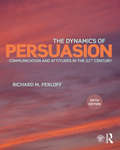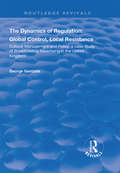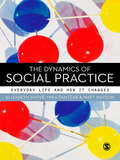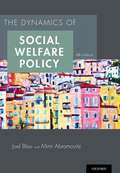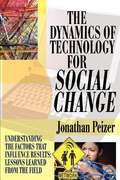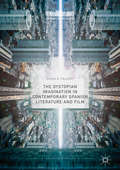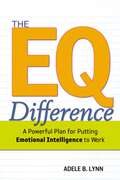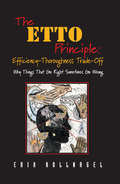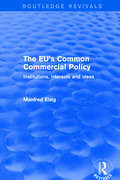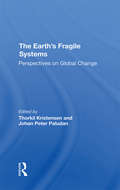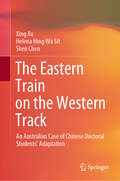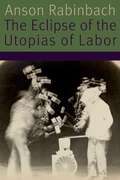- Table View
- List View
The Dynamics of Persuasion: Communication and Attitudes in the Twenty-First Century (Routledge Communication Series)
by Richard M. PerloffThe Dynamics of Persuasion has been a staple resource for teaching persuasion for nearly two decades. Author Richard M. Perloff speaks to students in a style that is engaging and informational, explaining key theories and research as well as providing timely and relevant examples. The companion website includes materials for both students and instructors, expanding the pedagogical utilities and facilitating adoptions. The sixth edition includes: updated theoretical and applied research in a variety of areas, including framing, inoculation, and self-affirmation; new studies of health campaigns; expanded coverage of social media marketing; enhanced discussion of the Elaboration Likelihood Model in light of continued research and new applications to everyday persuasion. The fundamentals of the book – emphasis on theory, clear-cut explanation of findings, in-depth discussion of persuasion processes and effects, and easy-to-follow real-world applications – continue in the sixth edition.
The Dynamics of Pilgrimage: Christianity, Holy Places, and Sensory Experience (Routledge Studies in Pilgrimage, Religious Travel and Tourism)
by Dee DyasThis book offers a systematic, chronological analysis of the role played by the human senses in experiencing pilgrimage and sacred places, past and present. It thus addresses two major gaps in the existing literature, by providing a broad historical narrative against which patterns of continuity and change can be more meaningfully discussed, and focusing on the central, but curiously neglected, area of the core dynamics of pilgrim experience. Bringing together the still-developing fields of Pilgrimage Studies and Sensory Studies in a historically framed conversation, this interdisciplinary study traces the dynamics of pilgrimage and engagement with holy places from the beginnings of the Judaeo-Christian tradition to the resurgence of interest evident in twenty-first century England. Perspectives from a wide range of disciplines, from history to neuroscience, are used to examine themes including sacred sites in the Bible and Early Church; pilgrimage and holy places in early and later medieval England; the impact of the English Reformation; revival of pilgrimage and sacred places during the nineteenth and twentieth Centuries; and the emergence of modern place-centred, popular 'spirituality'. Addressing the resurgence of pilgrimage and its persistent link to the attachment of meaning to place, this book will be a key reference for scholars of Pilgrimage Studies, History of Religion, Religious Studies, Sensory Studies, Medieval Studies, and Early Modern Studies.
The Dynamics of Regulation: Cultural Management and Policy: a case study of broadcasting advertising in the United Kingdom
by George GantziasThis title was first published in 2001. New technologies and the liberalization of the broadcasting and telecommunications market, together with the digitalization and globalization of new services, have challenged irrevocably not only the traditional markets and instructional structures but also the legal systems of broadcasting and telecommunication sectors in the 21st century. This text takes into account changes in digital broadcasting and telecommunication by pointing out that convergence is the process through which broadcasting, telecommunication, press and information sectors are transformed into new sectors (info-com arteries, info-com products, info-com services and info-com content) in order to be fully compatible with the emerging new info-communication industry in the digital transformation and info-communication era.
The Dynamics of Social Capital and Civic Engagement in Asia: Vibrant Societies (Routledge Contemporary Asia Series)
by Amrita Daniere Hy V. LuongThe purpose of this volume is to highlight the impacts on civic engagement of social capital, and its various component parts (trust, norms, networks and associations), in diverse parts of Asia. Addressing the pressing need for improved governance within the spatial, political and cultural realities in the rapidly transforming landscapes of Asia, the contributors to the book bring together interdisciplinary work that focuses on the ways in which civic engagement can link with social capital building. The goal of this volume is to inspire policy that recognizes that a vibrant society with access to rich stores of positive social capital requires civil society, alternate civilities and the state. The result is a dialogue on the interplay of social capital and civic engagement in socio-political contexts quite different from those found in the West. This book contributes to current discussions about the nature of social relations and their connection to politics and change and offers a unique lens into the validity of these important concepts in contemporary research across a variety of Asian settings. It will be of interest to social scientists across the board, especially those with an interest in Asia and Asian development.
The Dynamics of Social Practice: Everyday Life and how it Changes (Electronic Resource Ser.)
by Prof. Mika Pantzar Dr Matt Watson Dr Elizabeth ShoveEveryday life is defined and characterised by the rise, transformation and fall of social practices. Using terminology that is both accessible and sophisticated, this essential book guides the reader through a multi-level analysis of this dynamic. In working through core propositions about social practices and how they change the book is clear and accessible; real world examples, including the history of car driving, the emergence of frozen food, and the fate of hula hooping, bring abstract concepts to life and firmly ground them in empirical case-studies and new research. Demonstrating the relevance of social theory for public policy problems, the authors show that the everyday is the basis of social transformation addressing questions such as: * how do practices emerge, exist and die? * what are the elements from which practices are made? * how do practices recruit practitioners? * how are elements, practices and the links between them generated, renewed and reproduced? Precise, relevant and persuasive this book will inspire students and researchers from across the social sciences. Elizabeth Shove is Professor of Sociology at Lancaster University Mika Pantzar is Research Professor at the National Consumer Research Centre, Helsinki Matt Watson is Lecturer in Social and Cultural Geography at University of Sheffield.
The Dynamics of Social Welfare Policy (Fourth Edition)
by Joel Blau Mimi AbramovitzThe Dynamics of Social Welfare Policy uses the lens of an innovative policy model and an emphasis on social change to break new ground in social welfare policy texts. Starting from the explicit premise that every kind of social work practice embodies a social policy, the book stresses that policy knowledge enables social workers to help clients as well as to help themselves. Drawing on this awareness, the text then makes the standard social welfare policy material come alive by asking two new questions: 1) what factors trigger social change in these social policies?; and 2) how do these factors affect the social policies that influence what social workers actually do? To answer these questions, it develops a five-part policy model, which shows, through full chapters on each subject, how economics, politics, ideology, social movements, and the history of social welfare define social welfare policy.
The Dynamics of Technology for Social Change: Lessons Learned from the Field
by Jonathan PeizerTopics include: Sector dependencies, collaboration dynamics, information and communication technology challenges; nonprofit capacity issues and promising approaches; balancing the profit and value motive; implementation strategies; marketing and promotion strategies.
The Dynamics of a Changing Technology: A case study in textile manufacturing
by Peter J Fensham Dougles HooperTavistock Press was established as a co-operative venture between the Tavistock Institute and Routledge & Kegan Paul (RKP) in the 1950s to produce a series of major contributions across the social sciences. This volume is part of a 2001 reissue of a selection of those important works which have since gone out of print, or are difficult to locate. Published by Routledge, 112 volumes in total are being brought together under the name The International Behavioural and Social Sciences Library: Classics from the Tavistock Press. Reproduced here in facsimile, this volume was originally published in 1964 and is available individually. The collection is also available in a number of themed mini-sets of between 5 and 13 volumes, or as a complete collection.
The Dystopian Imagination in Contemporary Spanish Literature and Film (Hispanic Urban Studies)
by Diana Q. PalardyThis study examines contemporary Spanish dystopian literature and films (in)directly related to the 2008 financial crisis from an urban cultural studies perspective. It explores culturally-charged landscapes that effectively convey the zeitgeist and reveal deep-rooted anxieties about issues such as globalization, consumerism, immigration, speculation, precarity, and political resistance (particularly by Indignados [Indignant Ones] from the 15-M Movement). The book loosely traces the trajectory of the crisis, with the first part looking at texts that underscore some of the behaviors that indirectly contributed to the crisis, and the remaining chapters focusing on works that directly examine the crisis and its aftermath. This close reading of texts and films by Ray Loriga, Elia Barceló, Ion de Sosa, José Ardillo, David Llorente, Eduardo Vaquerizo, and Ricardo Menéndez Salmón offers insights into the creative ways that these authors and directors use spatial constructions to capture the dystopian imagination.
The ECPH Encyclopedia of Psychology
by Zhang KanThis encyclopedia volume comprehensively reflects the basic knowledge and the latest research results in the field of psychology. In this reference book, the knowledge system, basic concepts, basic theories, as well as important figures, representative works and institutions of psychology are well organized in encyclopedic entries. The whole work includes more than 1,300 entries and about 570 figures, making it a full and detailed introduction to the origin and development of psychology.
The EQ Difference: A Powerful Plan for Putting Emotional Intelligence to Work
by Adele LynnCo-published with SHRM. Emotional Intelligence (EI) is a strong indicator of individual, team, and organizational success. But stocking up on emotionally intelligent employees isn't enough: you need a concrete plan for putting this valuable resource to work. The EQ Difference offers an array of self-assessment tools and team-focused exercises that will help increase and leverage emotional intelligence both in individuals and in groups. It's filled with practical tips and suggestions for developing your own ""emotional quotient,"" as well as that of your peers, employees, and even senior executives. Featuring real workplace examples, Letters to Leaders, and excerpts from actual performance reviews that show the positive impact of EI in a variety of environments, The EQ Difference will help your organization achieve greater productivity, higher morale, and better employee retention -- all keys to stronger bottom line results.
The ETTO Principle: Why Things That Go Right Sometimes Go Wrong
by Erik HollnagelAccident investigation and risk assessment have for decades focused on the human factor, particularly 'human error'. Countless books and papers have been written about how to identify, classify, eliminate, prevent and compensate for it. This bias towards the study of performance failures, leads to a neglect of normal or 'error-free' performance and the assumption that as failures and successes have different origins there is little to be gained from studying them together. Erik Hollnagel believes this assumption is false and that safety cannot be attained only by eliminating risks and failures. The ETTO Principle looks at the common trait of people at work to adjust what they do to match the conditions - to what has happened, to what happens, and to what may happen. It proposes that this efficiency-thoroughness trade-off (ETTO) - usually sacrificing thoroughness for efficiency - is normal. While in some cases the adjustments may lead to adverse outcomes, these are due to the very same processes that produce successes, rather than to errors and malfunctions. The ETTO Principle removes the need for specialised theories and models of failure and 'human error' and offers a viable basis for effective and just approaches to both reactive and proactive safety management.
The EU in International Sports Governance: A Principal-agent Perspective Of Eu Control Of Fifa And Uefa (The European Union in International Affairs)
by Arnout GeeraertThis book demonstrates that the European Union (EU) can curtail the autonomy of FIFA and UEFA by building upon insights from the principal-agent model. The author argues that EU institutional features complicate control, but do not render the EU powerless, and that FIFA and UEFA can deploy a variety of strategies to mitigate control.
The EU's Common Commercial Policy: Institutions, Interests and Ideas
by Manfred ElsigThis title was first published in 2002. This volume aims to provide fresh insight into the complex struggles of the European Union (EU) institutions and the member states over who should negotiate trade issues on Europe's behalf. The book makes effective use of new empirical data on the daily operations of European trade policy based on interviews with high-ranking trade officials. Furthermore, this text is the first institutionalist analysis of the Amsterdam and Nice Intergovernmental Conferences (IGCs) in regards to the Common Commercial Policy (CCP). In sum, it provides the reader with an introduction into the field of international trade regulation from an EU perspective. Presented within the context of the long-standing institutional debate and using case studies on the operation of the CCP in the 1990s, this book facilitates a deeper understanding of the challenges facing Europe in the 21st century.
The Eagle Unbowed: Poland and the Poles in the Second World War
by Halik KochanskiWorld War II gripped Poland as it did no other country. Invaded by Germany and the USSR, it was occupied from the first day of war to the last, and then endured 44 years behind the Iron Curtain while its wartime partners celebrated their freedom. The Eagle Unbowed tells, for the first time, the story of Poland’s war in its entirety and complexity.
The Early Austrian School of Economics: Money, Value, Capital (Routledge Studies in Social and Political Thought)
by Christopher Adair-ToteffThis book explores the thought of the three ‘founding’ members of the Austrian School of economics: Carl Menger, Friedrich von Wieser, and Eugen Böhm-Bawerk, considering the overlapping and specialization of their work on money, value, and capital. Offering an incisive overview of the work of three important, but often-neglected figures, the author sheds fresh light on the transition from Adam Smith’s economics and the thought of the German School, to modern economic theory, considering also the influence of the Austrian School on the work of Max Weber. As such, it will appeal to scholars with interests in the history of ideas, economic theory, political economy, and social theory.
The Early Modern Hispanic World
by Rowe Kimberly Lynn Erin KathleenIberia stands at the center of key trends in Atlantic and world histories, largely because Portugal and Spain were the first European kingdoms to 'go global'. The Early Modern Hispanic World engages with new ways of thinking about the early modern Hispanic past, as a field of study that has grown exponentially in recent years. It focuses predominantly on questions of how people understood the rapidly changing world in which they lived - how they defined, visualized, and constructed communities from family and city to kingdom and empire. To do so, it incorporates voices from across the Hispanic World and across disciplines. The volume considers the dynamic relationships between circulation and fixedness, space and place, and how new methodologies are reshaping global history, and Spain's place in it.
The Earth's Fragile Systems: Perspectives On Global Change
by Thorkil Kristensen Johan Peter PaludanThe Earth's Fragile Systems is concerned with some of the most pressing and worrying of the problems afflicting our globe, problems that have been discussed in various forums and are well known not to be simple intellectually, practically or politically.
The Eastern Archaic, Historicized (Issues In Eastern Woodlands Archaeology)
by Kenneth E. SassamanThe Eastern Archaic, Historicized offers an alternative perspective on the genesis and transformation of cultural diversity over eight millennia of hunter-gatherer dwelling in eastern North America. For many decades, archaeological understanding of Archaic diversity has been dominated by perspectives that emphasize localized relationships between humans and environment. The evidence, shows, however that Archaic people routinely associated with other groups throughout eastern North America and expressed themselves materially in ways that reveal historical links to other places and times. Starting with the colonization of eastern North America by two distinct ancestral lines, the Eastern Archaic was an era of migrations, ethnogenesis, and coalescence—an 8,200-year era of making histories through interactions and expressing them culturally in ritual and performance.
The Eastern Church in the Spiritual Marketplace: American Conversions to Orthodox Christianity (NIU Series in Orthodox Christian Studies)
by Amy SlagleLike many Americans, the Eastern Orthodox converts in this study are participants in what scholars today refer to as the \u201cspiritual marketplace\u201d or quest culture of expanding religious diversity and individual choice- making that marks the post-World War II American religious landscape. In this highly readable ethnographic study, Slagle explores the ways in which converts, clerics, and lifelong church members use marketplace metaphors in describing and enacting their religious lives. Slagle conducted participant observation and formal semi-structured interviews in Orthodox churches in Pittsburgh, Pennsylvania, and Jackson, Mississippi. Known among Orthodox Christians as the \u201cHoly Land\u201d of North American Orthodoxy, Pittsburgh offers an important context for exploring the interplay of Orthodox Christianity with the mainstreams of American religious life. SlagleÆs second round of research in Jackson sheds light on the American Bible Belt where over the past thirty years the Orthodox Church in America has marshaled significant resources to build mission parishes. Relatively few ethnographic studies have examined Eastern Orthodox Christianity in the United States, and SlagleÆs book fills a significant gap. This lucidly written book is an ideal selection for courses in the sociology and anthropology of religion, contemporary Christianity, and religious change. Scholars of Orthodox Christianity, as well as clerical and lay people interested in Eastern Orthodoxy, will find this book to be of great appeal.
The Eastern Orthodox Church: Its Thought and Life
by Ernst BenzWestern European Christendom finds it difficult to comprehend the Eastern Orthodox Church because it knows little about the practice and doctrines of Orthodoxy. Even what is known is overlaid by many strata of prejudices and misunderstandings, partly political in nature. One of the obstacles has been the natural tendency to confound the ideas and customs of the Orthodox Church with familiar parallels in Roman Catholicism. To escape this tradition pitfall, Ernst Benz focuses on icon painting as a logical place to begin his examination of the Orthodox Church.Beginning with a brilliant discussion of the importance of icons in the Eastern Church--and the far-reaching effects of icons on doctrine as well as art--Benz counteracts the confusion, explaining simply and clearly the liturgy and sacraments, dogma, constitution and law of Eastern Orthodoxy. In brief history, he describes the rise of Orthodox national churches, schismatic churches, and churches in exile; the role of monasticism and its striking differences from Roman Catholic monasticism; the missionary work of the Orthodox Church; and the influence of Orthodoxy on politics and culture.The role of the church can be defined in terms of the image. Benz writes that the church exists so that "members may be incorporated into the image of Jesus Christ a in that individual believers are aechanged into his likeness'" as Paul writes in the second letter to the Corinthians. Thus, Orthodox theology holds up the icon as the true key to the understanding of Orthodox dogma. The Eastern Orthodox Church will be valuable to anyone interested in learning more about the church, its thought, its life, and its ideals.
The Eastern Train on the Western Track: An Australian Case of Chinese Doctoral Students’ Adaptation
by Xing Xu Shen Chen Helena Hing SitThis book makes valuable theoretical, empirical, and methodological contributions to the study of overseas doctoral students’ cross-cultural adaptation. Focusing on Australia, one of the top three destinations for Chinese students, this book seeks to understand how Chinese doctoral students perceive their lived experience of adapting to the academic and research environment at Australian universities. The book presents an innovative data collection chiefly based on interviews. It probes into Chinese doctoral students’ emic perception of their cross-cultural adaptation from a human development perspective and in three main phrases: how motivated and prepared they are for their overseas stay (planning), how they experience their adaptation as active agents (implementing), and how they evaluate their overseas doctoral journey after the fact (reflecting). Empirically speaking, its findings can help bolster the effectiveness of cross-cultural adaptation and that of the internationalisation of doctoral education. Methodologically speaking, it combines popular techniques and underused instruments such as graphics and maps to offer an in-depth portrait of the issue. Given its content, the book is primarily intended for researchers in cultural studies and practitioners in international education, or in a broader sense for anyone who has a keen interest in how individuals navigate the learning trajectory and construe meanings in unfamiliar academic and socio-cultural settings. Though the book focuses on Australia as a case study, its findings are equally applicable to other contexts.
The Eclipse of Equality: Arguing America on Meet the Press
by Solon SimmonsRed state vs. blue state. Republican vs. Democrat. Fox News vs. The Daily Show. The so-called culture wars have become such a fixture of American politics that dividing the country into rival camps seems natural and political gridlock seems inevitable. Entering the fray, Solon Simmons offers an intriguing twist on the debate: Our disagreements come not from unbridgeable divides, but from differing interpretations of a single underlying American tradition—liberalism. Both champions of traditional liberal values, Republicans have become the party of individual freedom while Democrats wear the mantle of tolerance. Lost in this battle of sides is the third pillar of liberalism—equality. Simmons charts the course of American politics through the episodes ofMeet the Press. On the air since 1945,Meet the Pressprovides an unparalleled record of living conversation about the most pressing issues of the day. In weekly discussions, the people who directly influenced policy and held the reins of power in Washington set the political agenda for the country. Listening to what these people had to say—and importantly how they said it—Meet the Pressopens a window on how our political parties have become so divided and how notions of equality were lost in the process. Telling the story of the American Century, Simmons investigates four themes that have defined politics and, in turn, debate onMeet the Press—war and foreign affairs, debt and taxation, race struggles, and class and labor relations—and demonstrates how political leaders have transformed these important political issues into symbolic pawns as each party advocates for their own understanding of liberty, whether freedom or tolerance. Ultimately, withThe Eclipse of Equality, he looks to bring back to the debate the question lurking in the shadows—how can we ensure the protection of a peaceful civil society and equality for all?
The Eclipse of Reason: Reclaiming Western Education for Today (Routledge Research in Education)
by Wilfred CarrThis concise, digestible book shows how the cultivation of reason became the defining aim of western education, and critiques how this aim has been eclipsed in recent decades by the neoliberal system of mass schooling imposed by the state.Chapters outline succinctly the history of western education and its origins in Ancient Greece, demonstrating how the idea of education as intrinsically related to the development of reason became embedded in the Western educational tradition, and how this tradition subsequently developed and evolved. Introducing key philosophical ideas about the nature of education, the book shows how the development of mass schooling in the 19th century led to our current educational landscape, where neoliberal demands for schools to be more responsive to market forces have obscured the development of reason as a distinctive educational aim. By inviting educators to think reflectively and critically about the state of education today, the book raises the little-discussed educational question of what comes after neoliberalism.Calling for the re-establishment of western education’s core values and aims, this book will be of interest to educators, researchers and students involved with pre- and in-service teacher education courses, as well as those interested in the history of education and the philosophy of education more broadly.
The Eclipse of the Utopias of Labor (Forms of Living)
by Anson RabinbachThe Eclipse of the Utopias of Labor traces the shift from the eighteenth-century concept of man as machine to the late twentieth-century notion of digital organisms. Step by step—from Jacques de Vaucanson and his Digesting Duck, through Karl Marx’s Capital, Hermann von Helmholtz’s social thermodynamics, Albert Speer’s Beauty of Labor program in Nazi Germany, and on to the post-Fordist workplace, Rabinbach shows how society, the body, and labor utopias dreamt up future societies and worked to bring them about. This masterful follow-up to The Human Motor, Rabinbach’s brilliant study of the European science of work, bridges intellectual history, labor history, and the history of the body. It shows the intellectual and policy reasons as to how a utopia of the body as motor won wide acceptance and moved beyond the “man as machine” model before tracing its steep decline after 1945—and along with it the eclipse of the great hopes that a more efficient workplace could provide the basis of a new, more socially satisfactory society.
